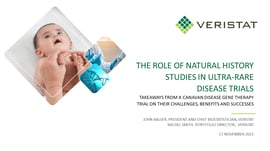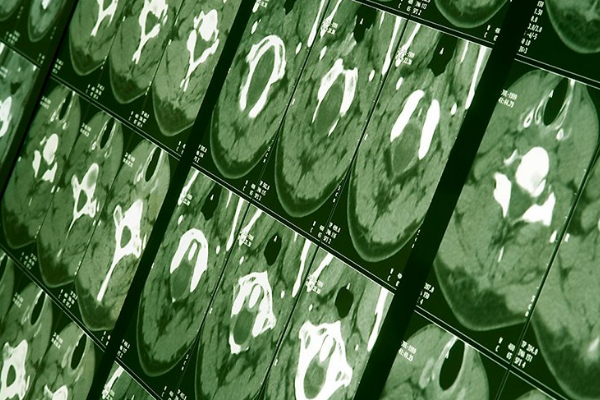Intro to Natural History Studies
ART PODCAST | SEASON 2 | EPISODE 2
In this episode of Advancing Revolutionary Therapies, a podcast presented by the Center of Excellence for Cell and Gene Therapies by Veristat, Chris Kenwood, Principal Statistician at Veristat, provides an introduction to Natural History studies for rare diseases.
Check out the full episode to learn more about the reasons for setting up Natural History studies and their challenges – or read the summary below.
Natural History Studies for Rare Diseases
What are Natural History studies and how are these relevant to cell and gene therapy development?
Chris: Cell and gene therapies are often evaluated in rare or ultra-rare disease research where there is a limited sample size available and few treatment options if any. In these diseases, there is sometimes limited information or knowledge about the rate of disease progression. There may be few medical experts and a lack of consensus regarding the standard of care.
Even when trying to define the endpoints for the assessment of efficacy and safety in clinical trials, we may not know what measures could be clinically relevant or how to compare scores over time to ensure we have adequate precision on observations and estimates. For these reasons, it is often difficult to perform randomized, comparative trials on the target population. Before we can evaluate a novel treatment, particularly one with a potentially permanent impact on the patient’s health, we must first understand (1) the patient population, (2) the disease progression, and (3) the expected changes in the disease over time.
What are the reasons for setting up Natural History studies?
Chris: Natural history studies provide many potential uses, benefits, and evidence for drug developers, and support clinical development in the following ways:
- Identify patient subgroups that may benefit from therapy.
- Identify or develop biomarkers.
- Identify or develop clinical outcome assessments.
- Serve as a control group or comparator data for an intervention trial within the same indication.
When I refer to a natural history study in this episode, I’m describing a study where there is no specified intervention or experimental therapy but where data are collected into a data capture system to better characterize the disease status and progression of patients identified as having one or more targeted diseases.

The Role of Natural History Studies in Ultra-Rare Disease Trials
What are the different types of Natural History Studies?
Chris: Natural history studies are often performed in pediatric populations, where the age of the patient may be influential in determining the rate of disease progression. A natural history study may be defined by its temporal perspective as retrospective, prospective, or have elements of both. Regardless, it is important for any natural history study to be governed through a specific protocol and a statistical analysis plan.
- A retrospective natural history study is where data is collected from existing medical records on evaluations and procedures that have already occurred. This type of study can be completed more quickly than a prospective study because the data is already available. However, retrospective studies can be challenging due to incomplete data, variability or inconsistency in the standard of care patients receive and/or the data collected itself. For example, data in medical records may not be documented through specific questionnaires, making the summary of the patient experience challenging given the inconsistency in reporting, thus limiting the interpretability when planning an intervention trial. There is also the risk of length-biased sampling and other selection biases due to differences in how patients may have been assessed based on varying historical approaches, changes in definition within the disease space, or consistency of data collection intervals and quality of information.
- A prospective natural history study is where contemporaneous data are collected on patients who are enrolled in the study. Evaluations are conducted according to a prespecified data collection plan that should reflect the current data standards to the extent possible. Such studies provide additional consistency to the collected data but may require more time than retrospective studies, particularly because they are designed to observe changes over time longitudinally.
Natural history studies may combine retrospective and prospective components from two separate patient cohorts for information collection, however, retrospective data collected can also function as a baseline for the prospective study. The implementation of such a flexible approach can increase the available information and allow for the collection of data across patients who have aged out of the targeted age range for pediatric studies, or who are deceased, as well as among living patients.
What types of sampling methods should Natural History studies follow?
Natural history studies can follow sampling methods defined as “cross-sectional” or “longitudinal.”
- Cross-sectional studies collect data from a cohort of patients during a specified, limited time period, where inferences regarding disease progression must be made by cross-patient comparisons. These can be retrospective or prospective and can be used to indicate the general course of the disease through various stages or age categories. However, the data may not fully characterize the disease course and may not fully identify disease subtypes. This can occur because different subtypes of disease can exist that may progress at varying rates or become symptomatic at different times during a patient’s life. It may be that information to distinguish between these subtypes is not available unless a patient is followed for a longer duration.
- Longitudinal studies collect data from each subject at several time points. These can also be retrospective or prospective and can provide a more comprehensive scope of information on disease onset and/or progression over time. Generally, longitudinal studies take more time to conduct than cross-sectional studies and can be more resource-intensive in staffing, costs, and patient or caregiver involvement.
A hybrid approach is also possible for sampling methods where different cohorts are followed for different periods of time. When planning the temporal perspective and sampling method for your natural history study, it is important to ensure that the key objectives are predetermined and that the requirements do not place an undue burden on the patients.
Leveraging Natural History Studies to Support Clinical Trials
Chris: The hybrid approach for both temporality and sampling allowed us to gather as much information as possible on the rare population. As we designed the natural history study in preparation for a future interventional trial, it was not clear how to appropriately measure disease progression over time. For some rare, genetic diseases, the patients cannot be appropriately compared to “normal” development tracks or more typical functional assessments. This is because the patient’s performance will fall too far below the “normal” performance or there is a lack of precision to determine changes over time.
How did you evaluate and determine relevant measurement tools and an appropriate set of criteria for the intervention study?
Chris: Our team worked closely with expert clinicians and patient advocacy groups in the planning of the protocol to determine what key criteria might be used to evaluate disease progression over time. As mentioned, no global, systematic study had been previously performed to assess disease characteristics over time, determine endpoints that are consistently measurable, or appropriately capture changes in disease progression among the identified patients.
It was important in the planning and design of this study to assess how we can collect information and measure multiple domains of illness, including potential delays in deterioration of functional assessments, quality of life, and any relevant biomarkers. The study protocol was carefully drafted as functional assessments were identified for use in the study. While the retrospective data extracted from medical records provide information on the progression of the disease and whether patients met generic developmental milestones, the measurement of targeted functional assessments would not be available from those sources. Information on such measures could be collected more standardly across patients and locations prospectively within the study, particularly to allow the measurement of changes over time.
Collaboration between patient advocacy groups, expert clinicians, Veristat, and the sponsor was critical to the authorship of the study protocol and the definition of the study endpoints for analysis. Through this process, we validated and defined a composite endpoint from data collected within the natural history study so that we could better capture the complex functional disease progression. Our team was also able to select biomarkers to determine their prognostic effect on disease progression.
Were there any unexpected challenges during this natural history study? If so, how did you resolve it?
After an extensive protocol development effort, the natural history study opened for enrollment in the second half of 2019 and, like many studies during that time, was impacted by the COVID-19 pandemic. In the execution of this trial, we had to adapt very quickly to determine how best to perform study-specific assessments at home or in satellite locations rather than require the patient and their family to travel. The sponsor, clinicians, and study staff came to an agreement on appropriate functional assessments and scales that could be performed in a remote fashion using HIPAA-compliant video-based technology, in lieu of in-person interactions. The study was able to continue, collecting the planned endpoints for analysis.
Video: Decentralized Solutions for Complex Clinical Trials | A Natural History Study Shifts to Virtual
What is the key to success for planning and executing a natural history study?
Like the study protocol, a collaborative effort was required for the development and finalization of the statistical analysis plan. The statistical analysis plan was designed to be flexible to accommodate important observations as the study progresses as well as to allow for unforeseen challenges with the amount of data that can be collected. Many graphical displays and figures plotting various outcome variables over time were planned to understand distributions and trajectories in the data. In the analysis plan, to the extent we could, we prospectively detailed the statistical analyses that will be implemented to measure and assess changes in disease progression as well as functional assessments over time; however, unlike a more typical prospective clinical trial, there is still much that is unknown about the course of the disease and the conclusions will be based more around the estimates and their respective variability than any single statistical hypothesis or test. In addition, the concepts of “multiplicity” or penalties for multiple interim analyses are not applicable in this study design.
We have recently initiated the intervention trial in this rare genetic disease and are excited to determine the effectiveness of the novel treatment method in comparison to the information collected from the natural history study. So far, we have learned about the progression of the disease over time, targeted potentially prognostic biomarkers, and established an understanding of the patient, caregiver, and clinician experience that will inform continued research into the future.
The key to the success experienced so far has been the open collaboration between the study sponsor, key opinion leaders and expert clinicians in the field, and patient advocacy groups. Each has a vast source of information from different perspectives. In particular, the advice from the patient advocacy groups can provide valuable information on appropriate functional assessments and the relative endurance of patients to undergo such assessments routinely.
Challenges of Planning Natural History Studies
Chris: The biggest challenge when planning a natural history study is to understand that you may not know much yet! The purpose of doing the natural history study is to gather more about a previously unmeasured disease. There is little information ahead of starting the study and therefore there are challenges and obstacles you meet along the way.
Approaching the study with an open mind and a willingness to be flexible, to listen to patient caregivers and advocacy groups, and collect and evaluate as much information as possible is essential for the successful planning and execution of a natural history study. As more novel therapies are developed, natural history studies will continue to be a critical tool to access available information on affected patients, to better understand disease progression over time, and establish appropriate endpoints for the assessment of new therapies for such rare diseases.










